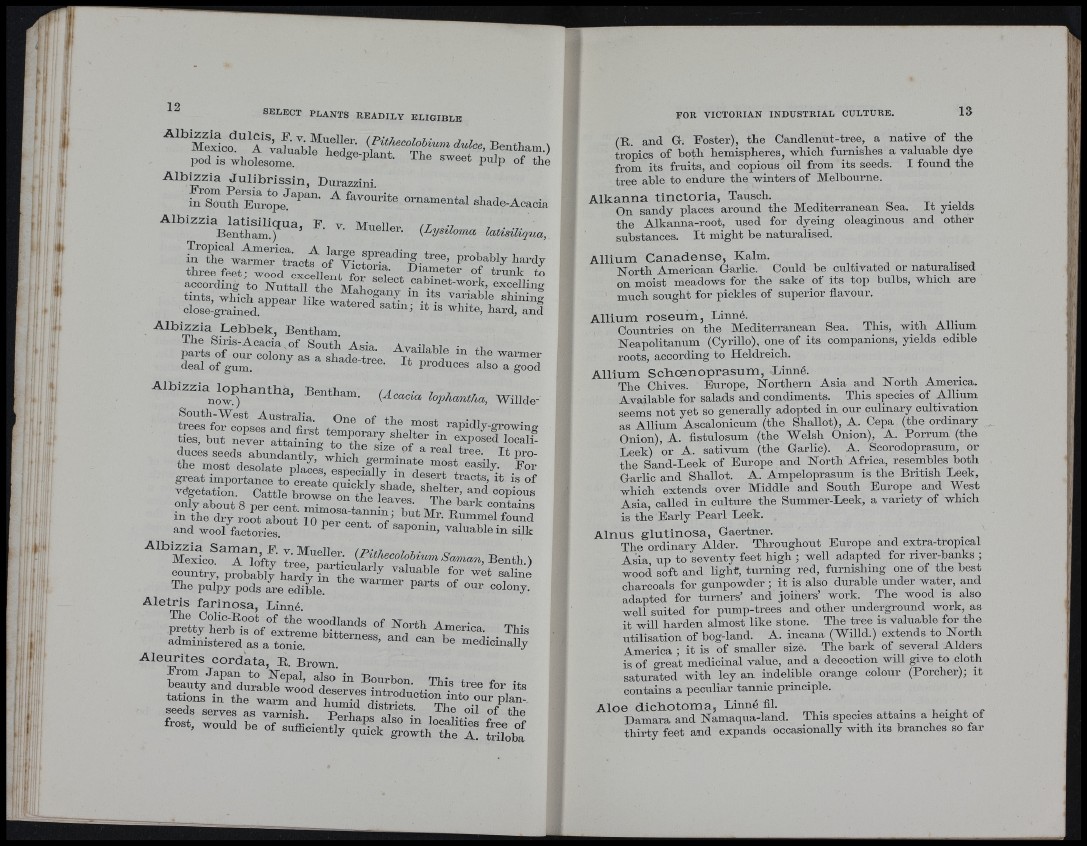
i I
pod is wholesome. ^ of the
A lb iz z ia J u l ib r i s s i n , Durazzini.
in Smith ^ ornamental shade-Acacia
{Lysiloma latisiliqua,
f o T T l 3 ” A ;„ ,te o f ''“■‘'t three feet; wood excellenf fnv of trunk to
according to Nuttall the M L cabinet-work, excelling
tìnte, wfioh 3 “ ™™ble .Lining
closeAained. ® ^ k k e , hard, and
Bentham.
p 3 deal o of gruom;A. c A o V U Asnat daet- ttreeeee. I t produces also a good
A l b i z z i a j o p h a n t h a , Bentham. (Aeaàa lopkantU, Willde-
» " e t e t r d l S t tem L A A U
f e , but n e A a t t a f n f o V t o T r L
duces seeds abundantly, which fferminatr D
the most desolate p la ^ s esnecifllv
great importance to create ouicklv A T tracts, rt is of
vdptation. Cattle browse on tiile a™ ? T h f b
only about 8 per cent rm'mn„„ i jeaTes, th e bark contains
in ihe dry lA t a W I o A r ?s o A “ “ ®‘
and wool factories. sapomn, valuable in silk
^ ^ ^ ‘S e o ^ ' ‘T k , f t y tre“ “p i ? 3 k r i 3 ? 3 3 “ ’
country, probably hardv rn fh 'valuable for wet saline
I t e pu'ip^ pods 3 e d t l e
Aletri^s f a r in o s a , Linné.
pretty ^ ^ o ric a This
administered as a tonic, ’ medicinally
A l e u r it e s c o r d a t a , R Brown.
beauty and dulabk woo/d^seivefi^^^^^^^
s r . i ; r r = r
- , — „ a .— s - ' s i ' s . a i r j s . i
(B. and G. Foster), the Candlenut-tree, a native of the
tropics of both hemispheres, which furnishes a valuable dye
from its fruits, and copious oil from its seeds. I found the
tree able to endure the winters of Melbourne.
Alkanna tinctoria, Tauscb. t l • m
On sandy places around the Mediterranean bea. i t yields
the Alkanna-root, used for dyeing oleaginous and other
substances. I t might be naturalised.
Allium Canadense, Kalm.
North American Garlic. Could be cultivated or naturalised
on moist meadows for the sake of its top bulbs, which are
much sought for pickles of superior flavour.
Allium roseum, Linné.
Countries on the Mediterranean Sea. This, with Allium
Neapolitanum (Cyrillo), one of its companions, yields edible
roots, according to Heldreich.
Allium S ch o en o p ra sum , Linné. , a
The Chives. Europe, Northern Asia and North America.
Available for salads and condiments. This species of Allium
seems not yet so generally adopted in onr culinary cultivation
as Allium Ascalonicum (the Shallot), A. Cepa (the ordinary
Onion), A. fistulosum (the Welsh Onion), A. Porrum (the
Leek) or A. sativum (the Garlic). A. Scorodoprasum, or
the Sand-Leek of Europe and North Africa, resembles both
Garlic and Shallot. A. Ampeloprasum is the British Leek,
which extends over Middle and South Europe and West
Asia, called in culture the Summer-Leek, a variety of which
is the Early Pearl Leek.
Alnus glutinosa, Gaertner, . . , ■ ^
The ordinary Alder. Throughout Europe and extra-tropical
Asia up to seventy feet high ; well adapted for river-banks ;
wood soft and light, turning red, fiirnisliing one of the best
charcoals for gunpowder ; it is also durable under water, and
adapted for turners’ and joiners’ work. The wood is also
well suited for pump-trees and other underground work, as
it will harden almost like stone. The tree is valuable for the
utilisation of bog-land. A. incana (Willd.) extends to North
America ; it is of smaller size. The bark of_ several Alders
is of o-reat medicinal value, and a decoction will give to cloth
saturated with ley an indelible orange colour (Porcher); it
contains a peculiar tannic principle.
Aloe dicBotoma, Linné fil. _ v • v ^
Damara and Namaqua-land. This specms attains a height ot
thirty feet and expands occasionally with its branches so far
;M{
li'
ih ■
■>!
f!